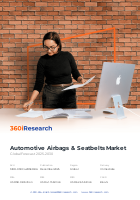
Automotive Airbags & Seatbelts Market by Product Type (Airbag, Seatbelt), Propulsion Type (Electric Vehicle, Fuel Cell Electric Vehicle, Hybrid Electric Vehicle), Material, Seatbelt Mechanism, Vehicle Type, Distribution Channel - Global Forecast 2025-2030
SKU
MRR-030C42D3ED8A
Region
Global
Publication Date
December 2025
Delivery
Immediate
2024
USD 38.08 billion
2025
USD 41.15 billion
2030
USD 62.65 billion
CAGR
8.64%

Download a Free PDF
Get a sneak peek into the valuable insights and in-depth analysis featured in our comprehensive automotive airbags & seatbelts market report. Download now to stay ahead in the industry! Need more tailored information? Ketan is here to help you find exactly what you need.



